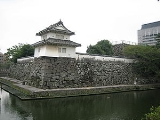
Yagura
Encyclopedia

Japanese castle
' were fortresses composed primarily of wood and stone. They evolved from the wooden stockades of earlier centuries, and came into their best-known form in the 16th century...
compounds, but can be used in a variety of other situations as well. The bandstand
Bandstand
A bandstand is a circular or semicircular structure set in a park, garden, pier, or indoor space, designed to accommodate musical bands performing concerts...
tower erected for Bon Festival
Bon Festival
or just is a Japanese Buddhist custom to honor the spirits of one's ancestors. This Buddhist-Confucian custom has evolved into a family reunion holiday during which people return to ancestral family places and visit and clean their ancestors' graves, and when the spirits of ancestors are supposed...
is often called a yagura, as are similar structures used in other festivals. Yagura-daiko, that is, taiko
Taiko
means "drum" in Japanese . Outside Japan, the word is often used to refer to any of the various Japanese drums and to the relatively recent art-form of ensemble taiko drumming...
drumming from atop a yagura is a traditional part of professional sumo
Sumo
is a competitive full-contact sport where a wrestler attempts to force another wrestler out of a circular ring or to touch the ground with anything other than the soles of the feet. The sport originated in Japan, the only country where it is practiced professionally...
competitions.
"Yagura" was also used more traditionally in the elaborate names of restaurants or other establishments, such as the "Color of Night Tower" (夜色楼), a popular and famous Edo period
Edo period
The , or , is a division of Japanese history which was ruled by the shoguns of the Tokugawa family, running from 1603 to 1868. The political entity of this period was the Tokugawa shogunate....
establishment in Kyoto
Kyoto
is a city in the central part of the island of Honshū, Japan. It has a population close to 1.5 million. Formerly the imperial capital of Japan, it is now the capital of Kyoto Prefecture, as well as a major part of the Osaka-Kobe-Kyoto metropolitan area.-History:...
.
The term originally derives from the use of fortress towers as arrow (矢, ya) storehouses (倉, kura), and was thus originally written as 矢倉. Today, modern towers such as skyscrapers or communications towers are almost exclusively referred to or named using the English-derived word
Gairaigo
Gairaigo is Japanese for "loan word" or "borrowed word", and indicates a transliteration into Japanese. In particular, the word usually refers to a Japanese word of foreign origin that was not borrowed from Chinese, primarily from English. Japanese also has a large number of loan words from...
tawaa (タワー), and not yagura.
Castle towers
Castle towers varied widely in shape, size, and purpose. Many served, of course, as watchtowers, guardtowers, and for similar military purposes. Arrows were often stored there, along with, presumably, other equipment. However, as castles also served as the luxurious home of Japan's feudal lords (the daimyōDaimyo
is a generic term referring to the powerful territorial lords in pre-modern Japan who ruled most of the country from their vast, hereditary land holdings...
), it was not uncommon for a castle to also have an astronomy tower, or a tower which provided a good vantage point for enjoying the natural beauty of the scenery.
Japan has rarely feared invasion or maintained border forts. However, it is not unlikely that various types of guardtowers or watchtowers would have been kept, outside of larger castle compounds, at various times and places throughout Japan's history.
Literature
- Turnbull, Stephen (2003). "Japanese Castles 1540-1640." Oxford: Osprey Publishing.

